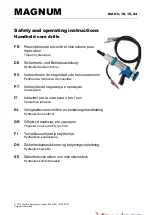
• Consult an expert when in doubt about the operation, safety or connection of
the device.
•
Maintenance, modifications and repairs must only be completed by a technician
or an authorised repair centre.
• If you have questions which remain unanswered by these operating instructions,
contact our technical support service or other technical personnel.
b) Device Handling
• Always keep the cable away from rotating parts of the device.
• Switch off the device once you are done with it. Wait until all moving parts have
come to a standstill. After switching off the device, the tools will rotate for a few
seconds longer.
• Never press the shaft locking device when the shaft is rotating.
• If you hear any unusual noises, immediately switch off the device and pull out
the power cord.
• Switch off the device immediately if you notice any unusual vibrations or other
indications of defect. Find out what the cause might be.
• Always keep the ventilation slits of the device clean and free of obstructions. The
motor fan sucks dust into the casing; heavy accumulations of metallic dust can
result in electrical hazards.
• Keep the device clear of rain or moisture. Water penetrating into an electrical
device increases the risk of electrical shock.
• Keep the cable away from heat, oil, sharp objects or moving parts of the device.
Damaged or tangled cables increase the risk of electrical shock. Do not use the
connector cable to carry or hang up the device or to pull the connector out of the
socket.
c) Operational Safety
• Avoid bodily contact with grounded surfaces such as water and gas pipes, heating
elements, stoves and refrigerators. There is an increased risk of electrical shock
if your body is grounded.
• If you are working with a power tool outdoors, use only extension cables that are
approved for outdoor use. The use of extension cables suited for outdoor use
decreases the risk of electrical shock.
• Keep your work area clean and tidy. Disorder and poor lighting or unlighted work
areas can lead to accidents.
18
















































